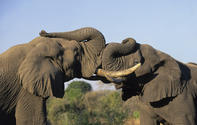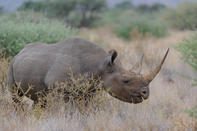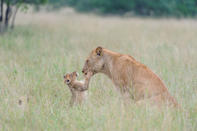Africa's Most Wanted
In the nineteenth century, the hunter epitomised bravery and pluck. The popular press was filled with exciting stories of life in the African bush, and the public lionised famous Big Game hunters, such as Frederick Courtney Selous, Denys Finch Hatton (who was portrayed by Robert Redford in Out of Africa) and William Cornwallis Harris.

It was the latter who said, “I have been accused of having shooting madness and truly a most delightful mania I have ever found it.”
It was during this time that the hunting fraternity in Africa coined the term ‘Big Five Game’. Today, this is best understood as a tourism term for the five animals you have to spot before you can go home.

The original concept, however, refers to the five species of African game that were considered the most dangerous to hunt. In no particular order, these were determined to be lion, rhino, leopard, buffalo and elephant.
The Big Five

The entrance criterion for the Big Five was evidently quite strict. Hippos, for example, were not included because it’s easy to shoot a hippo – just go down to the river and fire away. Large mammals such as giraffes, wildebeest and antelope were also excluded, as were lesser predators such as cheetahs, hyenas and wild dog. The list was so exclusive only the aggressive black rhino (which is prone to charge when cornered) made the cut.
The more passive white rhino was not originally part of the Big Five. In South Africa, however, we don’t like to judge things on the basis of colour, so we just refer to ‘rhino’. Whatever its origins, the Big Five concept plays an enormously important role in the popularity and marketing of wildlife reserves in South Africa. It is a keystone of our tourism industry; a convenient (if vague) label which has come to sum up the game viewing experience.
The Big Five are so central to the South African culture, they used to have pride of place on our currency – until the new ‘Randelas’ replaced them with an image of our beloved Madiba.
An Obsession

From a game viewing perspective, however, the Big Five are not particularly rare and not particularly big. Some say that they are not even that interesting. They are simply five species grouped together by a bunch of hunters over a century ago. And yet we still have an obsession with them.
Ask anyone who has visited the Kruger National Park what game they spotted and their answer will inevitably start with, ‘I saw four of the Big Five’. This is a bit of a pity. It takes attention away from many other, equally worthy species and causes tourists to get tunnel vision. But it’s all about marketing and there are few brands bigger than the Big Five.
Current Big 5

For the moment, any self-respecting game park simply has to contain the Big Five. It’s almost a prerequisite, a badge of authenticity, a vital accreditation. Basically, if your reserve doesn’t contain this cantankerous quintet, you’d better have something very special, like tap-dancing zebras, to have any chance of pulling in the crowds.
The Big Five (actually six) are: Lion (Panthera leo), African or Cape Buffalo (Syncerus caffer), Leopard (Panthera pardus), Black Rhino (Diceros bicornis), White Rhino (Ceratotherium simum), Elephant (Loxodonta africana).
By David Fleminger There is a wide variety of accommodation in Kruger National Park options ranging from rest camps to luxury Kruger Park safari lodges....
There is a wide variety of accommodation in Kruger National Park options ranging from rest camps to luxury Kruger Park safari lodges.... There are many different Kruger National Parks; the bush speaks in a multitude of voices and therefore appeals to a diverse group of people....
There are many different Kruger National Parks; the bush speaks in a multitude of voices and therefore appeals to a diverse group of people....